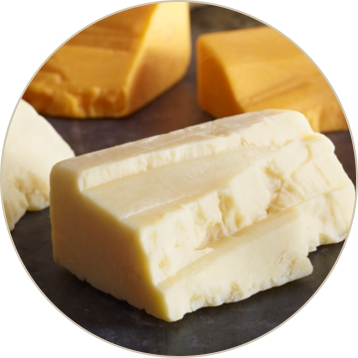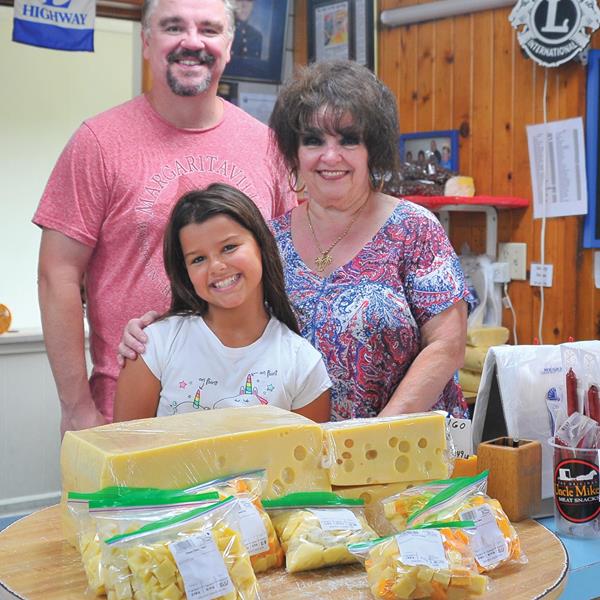Blog
Sharp Cheddar: An Explosion of Flavor
Imagine life without the presence of Cheddar Cheese or some form of it… Yep, it’s hard to imagine life without cheddar cheese — there’s a block of it in the fridge of nearly every household, ready to be sprinkled onto scrambled eggs, melted within grilled cheese sandwiches or stirred into cheese sauce for homemade macaroni and cheese.
Cheddar cheeses can becoming confusing with its complexities of flavors and appearances: some are white, some are yellow or orange, and some cheddars are mild, sharp or extra sharp. Cheddars seem to be the only cheese with that distinction, so what does it all mean? 
How is Cheddar Cheese Made?
Before we get to talking about sharp cheddar cheese, to begin, let’s delve into what cheddar is in the first place. It’s a cow’s milk cheese that originated in the village of Cheddar, England and has since grown immensely, taking the nation by storm, becoming one of the most popular and inexpensive cheeses in the US.
The cheddar-making process starts out like most other cheeses: the milk is cultured, a process in which starter bacteria is added to acidify the milk. When a sufficient amount of acid is produced, rennet is added and milk curds are formed. Upon the formation of these curds, the excess watery whey is drained out to leave behind mostly concentrated curds. These concentrated curds are then heated to about 100° F to release even more excess, watery whey and sequentially, begin the process of melting these curds together.
It’s at this point that cheddar continues on a different path,as compared to other cheeses, in cheese-making called the cheddaring process. The curds are formed into big slabs that are the piled together and flipped over several times, getting denser with each flip while releasing more of this watery whey. It is at this stage that the pressed curds are sent through a mill that produce smaller curds again before being pressed into molds to drain further and begin the aging process.
The Many Colors of Cheddar…
Why is some cheddar white while other variations of cheddar are yellow and others, orange? Historically, cheddars made in New England were not dyed and left white, while cheddars made elsewhere were dyed with things like annatto to help readily distinguis the cheddar’s origin. Today, it’s just a sense of consumer preference and both dyed and undyed variations of cheddar are still produced for consumption.

What Makes Cheddar Sharp?
Cheddar cheese is one of those unique cheeses in the dairy industry that has a its own descriptor before it, “sharp”. It’s carries this label rather loosely and is not regulated, so designations can be and tend to be inconsistent across various brands.
Sharp is a term that illustrates how cheddar changes in its flavor and texture over a period of time; for simplicity’s sake, sharp is used for cheddar as it ages… the stronger the bite, the longer it has been aged. Milder variations of cheddars are generally aged 2 to 3 months, sharper variations are aged 6 to 9 months, and extra-sharp are generally aged 1 to 2 years, before the final product. As cheddar ages, it goes from mild to tangier with more complex, deeper and bolder flavors. Its texture also goes from smooth and creamy to developing hard, salt-like crystals called calcium lactate. So, next time when you’re biting into an aged, Sharp Cheddar, and feel a crunch, it is these crystals that are producing this distinct crunch.
The best way to understand the age and sharpness of cheddar is to taste two different ages of cheddar side-by-side. Go with the same brand if possible to have a fair comparison and begin the aged cheddar tasting experience! Only then will you know if you like mild and creamy or nutty, tangy and bold.
Cooking with Cheddar
Whether just nibbling on cheddar or planning a dish involving Sharp Cheddar, the best practice is to go with the age (sharpness) of cheddar you think tastes the best. On the contrary, cooking with cheddar is an entirely different tale. The more aged the cheddar is, the less moisture it contains and the greater the heat needed to melt it. Mild or sharp cheddars melt the best, while aged cheddars tend to share melting behaviors similar to Parmesan cheese.
There you have it…. everything you need to know about cheddar and how to pick the right one at your local grocery store or specialty store. Shisler’s Cheese House carries a great selection of mild and aged cheddar cheeses!





